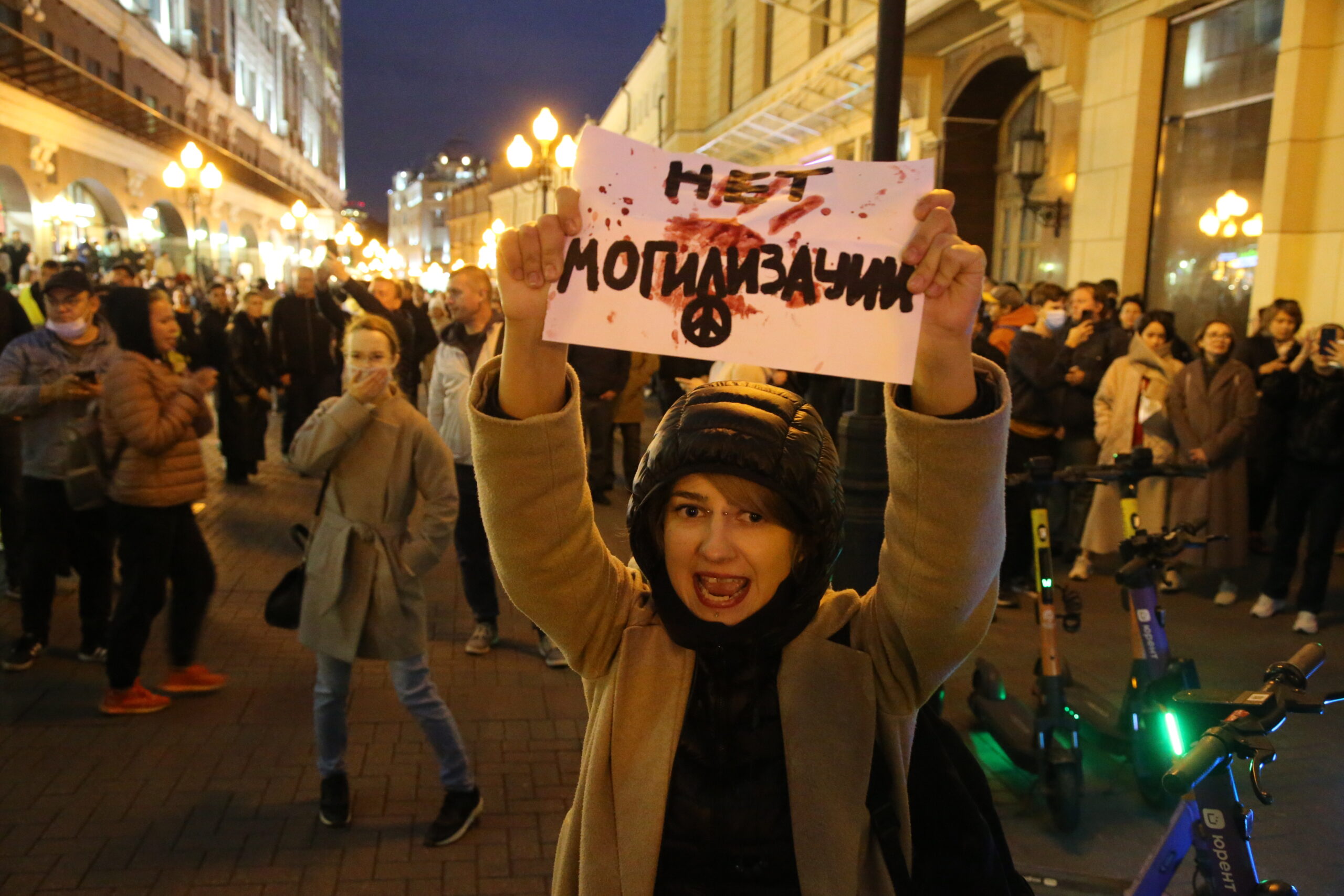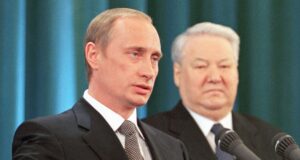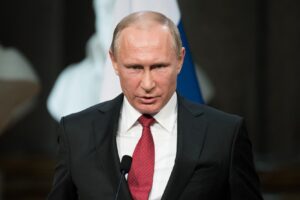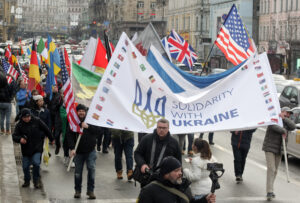
The Kremlin’s order to call up Russians to fight in Ukraine risks massive protests. It’s the riskiest decision of Putin’s rule, and it could lead to his undoing.
September 2022
On September 21, Russian president Vladimir Putin announced a partial military mobilization to support his war in Ukraine. It may be the riskiest political decision of his 22 years in power. Based on the war’s first seven months, new conscripts will be poorly trained, poorly equipped, poorly motivated, and poorly led. They are unlikely to reverse—and may even accelerate—Russia’s flagging fortunes on the battlefield. Putin’s order also carries significant domestic political risks that threaten to undermine his control and erode the stability of his regime.
Russia has only been mobilized for war on such a scale twice in its history. The first was in 1914 when Nicholas II required Russians to fight in the First World War, a conflict that resulted in the czar’s abdication and ultimately the Bolshevik Revolution of 1917. The second mass mobilization took place in 1941 when Stalin called up millions of Soviet citizens to repel Hitler’s invasion, an epic clash of two totalitarian tyrants with little regard for human life. History offers few clues for how Putin’s mobilization will affect Russia’s political stability.
Despite scarce precedents, Russia’s history of electoral fraud during Putin’s rule does suggest how Russia’s partial mobilization will unfold: who will be conscripted, where they will come from, why the Kremlin placed limits on the mobilization, how Russians are likely to react, and how the unpopular order might affect domestic political stability.
Widespread fraud has been a feature of Russian elections throughout the post-Soviet period. But as Russia’s flawed democracy under Boris Yelstin in the 1990s gave way first to Putin’s competitive authoritarianism in the mid-2000s and then consolidated dictatorship after 2012, the role of elections—and electoral fraud—in Russia’s political system has changed. In Putin’s Russia, stage-managed elections may not be exercises in democratic representation, but nor are they merely window dressing. Rather, they are a key control mechanism of Putin’s famous “power vertical.”
Throughout the Putin era, the Kremlin has tasked governors with rigging elections to deliver strong (if false) levels of popular support for Putin and his ruling party. As a groundbreaking study of electoral fraud noted, “absent the usual signals that a true democracy … provides, the Kremlin needs a way to judge the loyalty and competence of those outside its walls, and elections serve that purpose. A weak showing … signals a governor or local apparatus who needs replacement or outright incarceration.”
Such a system encourages regional elites to out-compete one another to demonstrate their loyalty and effectiveness to the Kremlin. This behavior may not be driven solely by governors’ considerations of personal power and position, though. The Kremlin’s goodwill may also produce more widespread benefits for obedient regions, including increased regional autonomy, direct budgetary support, and state-directed investment.
The mobilization decree Putin signed on September 21 orders governors to fill conscription quotas for their respective regions, thereby establishing an incentive structure similar to the one that motivates electoral fraud. As with rigged elections, governors know that their political survival in Russia’s increasingly repressive system may depend on their delivery of conscripts. Similarly, the tendency to “overfulfill” the plan may explain reports from across Russia of aggressive and brutal conscription tactics that appear to surpass the dictates set out in Putin’s decree.
Regional variation in Russia’s electoral fraud also illuminates the dynamics of Putin’s partial mobilization. The most severe electoral fraud takes place in Russia’s ethnic republics and autonomous regions, where the pro-Kremlin vote totals are inflated to absurd levels. Throughout the 2000s, this was especially the case in places such as Tatarstan, Chechnya, Dagestan, Ingushetia, North Ossetia, Bashkortostan, Chuvashia, and Mordovia.
Why are falsified vote totals so much higher in Russia’s ethnic republics, whose populations are majority non-Russian? First, regional political bosses in the ethnic regions enjoy stronger political control, authority, and autonomy than their counterparts in Russia’s non-ethnic oblasts. Some, such as Chechen strongman Ramzan Kadyrov, rule their fiefdoms with far more repressive tactics than other governors do. Their political machines have enhanced capacity to deliver whatever vote totals the Kremlin desires, and then some.
Second, research suggests that the populations of Russia’s ethnic republics may be more vulnerable to political pressure and manipulation. Vote buying and other forms of electoral manipulation are more prevalent in ethnic republics because of citizens’ dependency on established patronage networks, higher poverty rates, lower education levels, lower urbanization, greater dependence on state-owned enterprises, fewer media choices, and limited internet access.
The combination of powerful regional bosses and economically vulnerable populations in Russia’s ethnic regions means that these populations are unlikely to engage in mass demonstrations against electoral fraud, in contrast to the hundreds of thousands of citizens in Russia’s largest cities who protested in response to the fraudulent Duma elections of 2011 and presidential election of 2012. Taken together, this explains why electoral fraud has long been most severe in Russia’s ethnic periphery: It is easier for regional leaders to engineer and less likely to spark protest.
The same reality shapes military mobilization in Russia today. Even before Putin’s partial mobilization, evidence suggested that the military was recruiting volunteers for the war in Ukraine most heavily among non-ethnic Russian populations and regions. Although Putin’s decree specified that the Ministry of Defense would set conscription quotas for each region, many predicted that conscripts would be drawn disproportionately from Russia’s ethnic minorities for they—tragically—are considered “expendable.”
Early evidence confirms that predictions of disproportionate and overzealous conscription efforts in regions such as Dagestan, Buryatia, Bashkortostan, and Yakutia are well founded. But unlike manipulated elections in these regions, this time Russia’s ethnic minorities are pushing back against their governors. Spontaneous protests have broken out across many such regions, along with several cases of arson at recruitment centers, and at least one attack on military recruiters by a gunman in the Siberian region of Irkutsk. Passive in the face of years of electoral fraud, many of Russia’s vulnerable populations appear to have finally found grounds to resist.
This raises the question of whether antimobilization protests across Russia might be enough to weaken Putin’s political control or even threaten his regime’s survival. Once again, research on electoral fraud and mass protest in Russia and other post-Soviet states can offer clues. Scholars recognize that mass protests in authoritarian regimes are bedeviled by a collective action problem: If enough citizens protest they can force change, but due to the high costs of protesting (especially if one does so alone), the rational strategy is to stay at home and let others pay the price. With all but the most dedicated antiregime activists following this logic, mass protest fails to materialize.
But one of the key insights of the color revolutions that swept the post-Soviet space in the mid-2000s was that stolen elections can serve as focal points concentrated in space and time that serve as collective insults to a large segment of society. Under particular conditions, this may be enough to lower the barriers to collective action, yielding what some scholars have termed the “electoral model” of mass uprisings in the post-Soviet space.
Might Putin’s mobilization drive become just such a focal point for his critics to take to the streets in mass protest? There is no doubt that the partial mobilization is unpopular: Protests have, indeed, broken out across Russia. Additionally, Putin’s order to draft Russians with prior military experience has sparked a mass exodus of Russian men (regardless of military background or reserve status). Estimates suggest that hundreds of thousands of Russians fled the country within the first week of the mobilization. But every Russian man who flees is one fewer potential protester, a dynamic that could change if Putin seals the borders and traps would-be dissenters inside Russia.
These protests have yet to reach a size that threatens Putin’s grip on power. Recognizing the risks of a full mobilization and general draft that could spark nationwide protests, the Kremlin likely settled on the partial mobilization (with a stated target of 300,000 conscripts) to limit the spread of popular dissent. However, media reports of a secret redacted paragraph in the decree calling for a million conscripts imply that the Kremlin may be trying to execute a full mobilization in salami slices to avoid a broader uprising.
Will Putin’s mobilization—partial or otherwise—manage to thread the needle and generate new military manpower while avoiding destabilizing mass protests? In a seminal 1991 article, Timur Kuran proposed an innovative model for understanding how the wave of anticommunist mass uprisings that swept across Eastern Europe in 1989 came out of nowhere yet seemed inevitable in retrospect.
Recognizing that the logic of collective action should make any antiregime protest relatively rare, Kuran noted that it is difficult to judge the true level of regime support in a dictatorship based on lack of public dissent. This is because of preference falsification: Citizens may act publicly as if they support the regime, while privately holding antiregime beliefs. These they keep to themselves due to the high cost of opposition and because they do not know which and how many of their fellow citizens share their views.
But each citizen has a unique “revolutionary threshold” or breaking point at which they are fed up enough to step into the streets in protest. Some may not feel safe opposing the regime until the streets are already packed with protesters. Others may be willing to take public action when only a small portion of society is already protesting. But until private preferences are revealed through public action, it is nearly impossible to know any society’s underlying wellspring of dissent.
Events can unexpectedly and rapidly lower the thresholds of a wide swath of society to act, setting in motion a cascade that can bring millions into the streets in the blink of an eye. Such events can include economic crises, natural disasters, military defeat, electoral fraud, regime violence, and policy missteps by the regime, to name a few.
Though many in the West hope that Putin’s military mobilization unleashes a massive wave of pent-up dissent, Kuran’s model reminds us that humility is warranted. Because of the Kremlin’s powerful propaganda machine and domination of the information space within Russia, we cannot judge the true level of mass support for Putin or his war. Nor can we know just how close Russians—whether individually or collectively—are to reaching their breaking point and unleashing a revolutionary cascade that could topple Putin’s dictatorial regime.
What we do know is that if Putin’s iron grip on Russia is shattered by mass protest one day, it will likely emerge suddenly and unexpectedly but appear inevitable in retrospect. Someday, when students ask how Putin’s Russia collapsed, their professors may well evoke Ernest Hemingway’s classic reflection on bankruptcy: “Two ways. Gradually, then suddenly.”
Robert Person is associate professor of international relations at the U.S. Military Academy, director of its international affairs curriculum, and faculty affiliate at its Modern War Institute. His next book, Russia’s Grand Strategy in the 21st Century, is forthcoming. The views expressed in this essay are the author’s own and do not reflect the official position of the U.S. Army, Department of Defense, or U.S. Government.
More from the Journal of Democracy:
 |
 |
 |
|
Russia’s Road to Autocracy |
How Putin’s War in Ukraine Has Ruined Russia |
What Putin Fears Most By Robert Person and Michael McFaul |
Copyright © 2022 National Endowment for Democracy
Image Credit: Contributor/Getty Images
